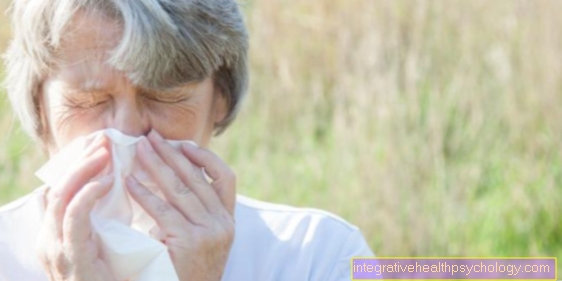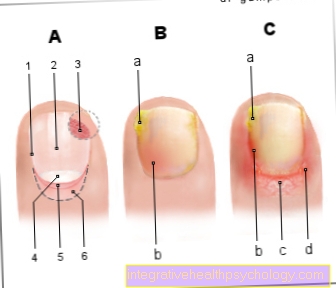Three-day fever in the baby - is it dangerous?
General

In three-day fever, which is also synonymous as Exanthema subitum, Roseola infantum or older is called the Sixth Disease, it is one of the classic childhood diseases of the first two years of life. Almost all children in their third year of life have got the disease behind them or at least carry the pathogen. Older children and adults have a lower risk of developing the disease.
Symptoms
Three-day fever has very characteristic symptoms, which makes it easy to diagnose.
The main characteristic of this viral disease is undoubtedly the high fever. It usually comes very quickly and climbs up in no time. It can reach up to 41 degrees. With a fever, especially when it is so high, many children have feverish dreams and are confused.
The fever is mostly accompanied by the usual symptoms like chills. Accompanied sweats, fatigue, loss of appetite, paleness and headache.
Unfortunately, with the suddenly rising fever, febrile seizures can also occur. If the small patient suffers from it, it is essential to call the emergency doctor immediately, as this can be very dangerous for the small child.
After about 3 to 4 days, the fever will return to normal within a few hours. The child is usually completely free of fever afterwards.
Another symptom that is typical of three-day fever becomes noticeable. The children get a rash, especially in the trunk area, which in many children neither itches nor hurts and is typical of a rash in three-day fever. After a few days, this rash spreads over the entire body. However, the face is the only area spared in some children. How long the rash lasts varies. For most children, however, one speaks of a period of one to 3 or 4 days until this completely subsides.
In many children, in addition to the symptoms mentioned, you can also find swollen lymph nodes, for example. These are swollen because the immune system has to work to remove the pathogens, in this case viruses, from the body. The lymph nodes are part of the immune system.
In addition, the viral disease can lead to further, rather atypical symptoms. These are gastrointestinal complaints such as diarrhea, constipation, flatulence, but also vomiting. With diarrhea and vomiting in particular, there is always the risk that the child will dry out, which is why you have to be very careful here and give enough fluids.
Often the throat is also red and swollen.
The disease is basically harmless. Only the febrile seizures that occur occasionally are not without danger. You should definitely call a doctor. There have been reports that children who have had a bone marrow transplant can often carry severe infections in the brain and lungs. But these are exceptions, which occur very rarely.
causes
The three day fever is one acute illness of the baby and will caused by a virusbelonging to the group of Herpes viruses heard.
This group includes 8 different virus types, one of which is the classic cold sore evokes. This is primarily responsible for the three-day fever human herpes virus (HHV-) 6, isolated cases are also assigned to HHV-7.
A typical feature of herpes viruses is that they were not destroyed or neutralized after the illness, but rather remain inactive in the body and reactivated under certain circumstances can be.
So it happens that the transmission on the baby by healthy adults or children happens. Since the baby has not yet been confronted with this pathogen, the disease breaks out and is noticeable with its typical course.
In people who have already been through the disease, specific antibodies against the virus are then in the blood, which prevent it from breaking out again and make you immune to HHV-6 or HHV-7 for the rest of your life.
Course of three-day fever
After the infection, i.e. the absorption of the pathogen, it takes a certain time for the virus to spread in the baby.
After this so-called Incubation period of 5-15 days occurs first, apparently for no apparent reason high fever with values up to 40 degrees on which on average Lasts for 3 days - hence three-day fever.
By definition, temperatures above 38 degrees Celsius are referred to as fever, and values up to 38 degrees Celsius are referred to as elevated temperatures. In extreme cases, the baby can have a fever for up to 8 days.
Usually it then completely regresses spontaneouslywithout harming the baby.
This includes the three-day fever classic rash on. It is about many reddish spots, the first on the chest, stomach and neck appear. Some of these spots can be raised, so they can be felt with the finger. In some cases, they connect planarly and go over to the face. This rash caused no itchingwhat sets it apart from many other rashes that occur with childhood diseases.
If this picture looks dangerous to many parents, it is Not harmful to the baby's health. Rather, it is a sign that the disease is in the subsiding phase and the fever is over.
In a not uncommon number of cases, the three-day fever occurs without the baby developing the typical complexion. Here one speaks of the abortive form.
In addition to these harmless processes, which are observed in most cases, it can also occur in some cases other symptoms come. Above all is the Febrile seizure that can occur as a result of the rapidly rising fever and with Muscle twitches and brief cloudings of consciousness goes with the baby. However, one needs to know that this type of cramp is harmless is and stops spontaneously.
A Clarification of this event is still usefulto treat other convulsive diseases such as Rule out epilepsy in the baby.
In addition, the three-day fever can show other unspecific symptoms. These include on the one hand Gastrointestinal complaintswho deal with diarrhea show, or also Swelling around the eyes (Eyelid edema) or the lymph nodes on the neck. The sick baby can also be under cough and sneeze Suffer.
Overall, it must be said that despite the symptoms mentioned, the three-day fever in the great majority of cases to the harmless childhood diseases without damaging potential counts.
Nevertheless, one should consult a doctor for clarification, also because the pediatrician would like to be informed about high fever in the first few years.
Healthy adults do not usually get three-day fever. People under more aggressive that immune system debilitating therapy such as one chemotherapy however, the virus can harm.
Diagnosis
The three-day fever in the baby can usually be diagnosed solely through the clinic, i.e. the symptom complex to be observed:
of the typical rapid rise in fever, the appropriate age up to 2 years and, above all, that of it subsequent classic rash, which follows the fever drop.
However, it must be remembered that many other infections cause fever. These include Urinary tract infections or Pneumonia. Likewise the red, blotchy rash not with measles or rubella be confused.
In addition to the visual diagnosis along with a fever, there is the possibility of having the three-day fever laboratory tests diagnose the blood. Here the doctor leaves certain defense proteins against the virus in the baby, the Antibodies to HHV-6, determine.
therapy
As described above, three-day fever is caused by viruses.
In contrast to Antibiotics do not work here, as these are directed against certain metabolic processes that a virus does not have. They do not have their own metabolism and need a living organism like humans to survive and multiply.
As a therapy are therefore in the first line symptomatic measures in the foreground and not causal ones that fight the cause.
This includes in general antipyretic measures how thin clothes and no blankets that are too warmthat would trap the heat. As a classic, well-known household item, you can give the baby Calf wrap knock down. To do this, cotton or linen towels are soaked in water at around 20 degrees Celsius and placed around the calves several times. The direct cooling effect is good for the baby and the evaporating water removes heat from the body; the same mechanism as when sweating.
Also antipyretic drugs can be used. However, it must absolutely avoid aspirin. There are special ones for the baby Fever suppositories or Juice preparationsthat won't harm the baby.
In any case, it is important to have one adequate hydration to pay attention.
If febrile seizures occur, the doctor may advise soothing and antispasmodic drug prescribe.
One should, however never stop medication for the baby without consulting a specialist!
If a fever develops, which lasts and rises for several days, a doctor must be consulted to rule out other serious illnesses.
Currently exists no possibility of vaccination.
Other babies or small children should not be allowed to come into contact with the sick baby because of the risk of infection.
forecast
The forecast for a baby with three-day fever very good. Most of the time the disease runs harmless from and disappears spontaneously after a short timeso that the baby recovers quickly. Often there are weakened forms that the parents do not notice. The Febrile seizures do not cause any harm either. Just very rarely do complications occur.
How contagious is the three-day fever?
The Three-day fever (Exanthema subitum) is highly contagious. The viruses, (HHV-6 and HHV-7) that come from the herpes virus family are about Droplet infection transmitted from person to person. Droplet infection means that you can get the virus through Sneeze, Cough or also Speak and Kiss can transfer to another person.
You can actually feel safe from infection hardly protect, because it neither a vaccination gives, still other drugs for prophylaxis. Especially when the kids are in kindergarten or are in elementary school, they can no longer be protected from infection, as children put everything in their mouths and are very close when they play.
Especially Adults to have often coughif they have the disease and so can the viruses very easy to distribute.
Once you have the viruses in your body, they stay there for a lifetime and you are always protected. The the pathogen remains lifelong in the body also has one disadvantage. One can also Years later still infect his fellow men. This is also the reason why children keep coming back through their Mothers infected without having any other acute symptoms.
However, even if the disease is easily transmitted, it is not necessary Isolate children. However, there are certain points to stick to. It should be out of contact too pregnant women distance be taken, as well as one should keep oneself or the children away from people whose immune system is very bad, for example by a chemotherapy or Other diseases.
Rash in three-day fever
The rash in three-day fever has a typical appearance. He kicks straight after this Fever and is first in the area of the Belly, of Neck and the chest to see. There are very small red dots, Which Cover the skin extensively. But sometimes they also grow into each other.
Usually this rash doesn't itch and he also prepares no pain. Nevertheless, here too, children repeatedly complain about the opposite.
In the course of the disease the rash spreads often on the rest of the body, but usually that remains Face free from the red spots.
The rash is slightly raised, that means that you can feel it when you run your hand or finger over it. In children, this is sometimes why they care scratch and sometimes even slight scars remain can.
But the rash is completely harmless, even if it may seem different. To have to no special drugs be taken, because it usually disappears by itself. However, it should itch or pain, is there special creams and Tinctures.





























